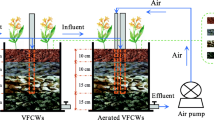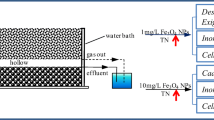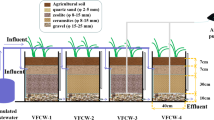Abstract
This study explored the influence of ferrous iron (Fe2+) addition on ammonium nitrogen (NH4-N) removal and microbial communities in horizontal subsurface flow constructed wetlands (HSSFs) at different carbon/nitrogen (C/N) ratios. Fe2+ addition could improve NH4-N removal under the C/N ratio of 2.1 and alter the microbial community structure. The microbial diversity and functional genes at the C/N ratio of 2.1 were enhanced by the addition of 50 mg/L Fe2+, with the increases observed in NH4-N and total nitrogen (TN) removal. This indicates the enhancement of nitrogen removal by Fe2+ addition with the presence of high organic matter. However, the enhancement of Fe2+ on chemical oxygen demand removal was not obvious overall. The relative abundance of functional genes and those related to energy metabolism, xenobiotic biodegradation, and metabolism decreased significantly in HSSFs with Fe2+ at C/N ratio of 1.1, whereas they increased in HSSFs with the addition of 50 mg/L Fe2+ at C/N ratio of 2.1.








Similar content being viewed by others
References
Albuquerque A, Oliveira J, Semitela S, Amaral L (2009) Influence of bed media characteristics on ammonia and nitrate removal in shallow horizontal subsurface flow constructed wetlands. Bioresource Technology 100(24):6269–6277
Amato KR, Yeoman CJ, Kent A, Righini N, Carbonero F, Estrada A, Gaskins HR, Stumpf RM, Yildirim S, Torralba M, Gillis M, Wilson BA, Nelson KE, White BA, Leigh SR (2013) Habitat degradation impacts black howler monkey (Alouatta pigra) gastrointestinal microbiomes. The ISME Journal 7(7):1344–1353
APHA, 1998. Standard methods for the examination of water and wastewater. 20th, American Public Health Association, American Water Works Association, Water Pollution Control Federation. Washington, DC
Cano V, Vich DV, Andrade HH, Salinas DT, Nolasco MA (2020) Nitrification in multistage horizontal flow treatment wetlands for landfill leachate treatment. Science of the Total Environment 704:135376
Chen H, Yu JJ, Jia XY, Jin RC (2014) Enhancement of anammox performance by Cu (II), Ni (II) and Fe (III) supplementation. Chemosphere 117:610–616
Chen X, Zhu H, Yan B, Shutes B, Xing D, Banuelos G, Cheng R, Wang X (2020) Greenhouse gas emissions and wastewater treatment performance by three plant species in subsurface flow constructed wetland mesocosms. Chemosphere 239:124795
Coby AJ, Picardal F, Shelobolina E, Xu H, Roden EE (2011) Repeated anaerobic microbial redox cycling of iron. Applied and Environmental Microbiology 77(17):6036–6042
Cooper PF, Job GD, Green MB, Shutes RBE (1996) Reed beds and constructed wetlands for wastewater treatment. WRc Publications, Medmenham, p 184
Ding B, Li Z, Qin Y (2017) Nitrogen loss from anaerobic ammonium oxidation coupled to Iron (III) reduction in a riparian zone. Environmental Pollution 231:379–386
Ding L, An X, Li S, Zhang G, Zhu Y (2014) Nitrogen loss through anaerobic ammonium oxidation coupled to iron reduction from paddy soils in a chronosequence.Environmental Science & Technology 48:10641−10647
Du R, Peng Y, Cao S, Li B, Wang S, Niu M (2016) Mechanisms and microbial structure of partial denitrification with high nitrite accumulation. Applied Microbiology and Biotechnology 100(4):2011–2021
Fan J, Zhang B, Zhang J, Ngo HH, Guo W, Liu F, Guo Y, Wu H (2013) Intermittent aeration strategy to enhance organics and nitrogen removal in subsurface flow constructed wetlands. Bioresource Technology 141:117–122
Gu Y, Wei Y, Xiang Q, Zhao K, Yu X, Zhang X, Li C, Chen Q, Xiao H, Zhang X (2019) C: N ratio shaped both taxonomic and functional structure of microbial communities in livestock and poultry breeding wastewater treatment reactor. Science of the Total Environment 651:625–633
Guo J, Peng Y, Fan L, Zhang L, Ni BJ, Kartal B, Feng X, Jetten MS, Yuan Z (2016) Metagenomic analysis of anammox communities in three different microbial aggregates. Environmental Microbiology 18(9):2979–2993
Ilyas H, Masih I (2017) The performance of the intensified constructed wetlands for organic matter and nitrogen removal: a review. Journal of Environmental Management 198:372–383
Janjit I, Su WY, Jae SR (2007) Nutrient removals by 21 aquatic plants for vertical free surface-flow (VFS) constructed wetland. Ecological Engineering 29(3):287–293
Kanaparthi D, Conrad R (2015) Role of humic substances in promoting autotrophic growth in nitrate-dependent iron-oxidizing bacteria. Systematic and Applied Microbiology 38(3):184–188
Kiskira K, Papirio S, van Hullebusch ED, Esposito G (2016) Fe(II)-mediated autotrophic denitrification: a new bioprocess for iron bioprecipitation/biorecovery and simultaneous treatment of nitrate-containing wastewaters. International Biodeterioration & Biodegradation 119:631–648
Kiskira K, Papirio S, van Hullebusch ED, Esposito G (2017) Influence of pH, EDTA/Fe(II) ratio, and microbial culture on Fe(II)-mediated autotrophic denitrification. Environmental Science and Pollution Research International 24:21323–21333
Langille MG, Zaneveld J, Caporaso JG, McDonald D, Knights D, Reyes JA, Clemente JC, Burkepile DE, Vega Thurber RL, Knight R, Beiko RG, Huttenhower C (2013) Predictive functional profiling of microbial communities using 16S rRNA marker gene sequences. Nature Biotechnology 31(9):814–821
Li F, Lu L, Zheng X, Zhang X (2014) Three-stage horizontal subsurface flow constructed wetlands for organics and nitrogen removal: effect of aeration. Ecological Engineering 68:90–96
Li X, Yuan Y, Huang Y, Liu HW, Bi Z, Yuan Y, Yang PB (2018) A novel method of simultaneous NH4+ and NO3− removal using Fe cycling as a catalyst: Feammox coupled with NAFO. Science of the Total Environment 631:153–157
Liu H, Chen Z, Guan Y, Xu S (2018) Role and application of iron in water treatment for nitrogen removal: a review. Chemosphere 204:51–62
Maltais-Landry G, Maranger R, Brisson J, Chazarenc F (2009) Nitrogen transformations and retention in planted and artificially aerated constructed wetlands. Water Research 43(2):535–545
Mayo AW, Bigambo T (2005) Nitrogen transformation in horizontal subsurface flow constructed wetlands I: model development. Physics and Chemistry of the Earth, Parts A/B/C 30(11–16):658–667
Pan XF, Zhu H, Yan BX, Su SH, Wang XJ, Li PF (2015) Simulation research of effect of exogenous iron on removal of nitrogen in subsurface flow constructed wetlands. Wetland Science 13(3):350–355 (In Chinese)
Pelissari C, Sezerino PH, Decezaro ST, Wolff DB, Bento AP, de Carvalho Junior O, Philippi LS (2014) Nitrogen transformation in horizontal and vertical flow constructed wetlands applied for dairy cattle wastewater treatment in southern Brazil. Ecological Engineering 73:307–310
Philippot L, Spor A, Hénault C, Bru D, Bizouard F, Jones CM, Sarr A, Maron PA (2013) Loss in microbial diversity affects nitrogen cycling in soil. The ISME Journal 7(8):1609–1619
Saeed T, Sun G (2012) A review on nitrogen and organics removal mechanisms in subsurface flow constructed wetlands: dependency on environmental parameters, operating conditions and supporting media. Journal of Environmental Management 112:429–448
Schiff SL, Tsuji JM, Wu L, Venkiteswaran JJ, Molot LA, Elgood RJ, Paterson MJ, Neufeld JD (2017) Millions of boreal shield lakes can be used to probe Archaean Ocean biogeochemistry. Scientific Reports 7:46708
Segata N, Izard J, Waldron L, Gevers D, Miropolsky L, Garrett WS, Huttenhower C (2011) Metagenomic biomarker discovery and explanation. Genome Biology 12(6):R60
Shrestha J, Rich JJ, Ehrenfeld JG, Jaffe PR (2009) Oxidation of ammonium to nitrite under iron-reducing conditions in wetland soils: laboratory, field demonstrations, and push-pull rate determination. Soil Science 174(3):156–164
Shu D, He Y, Yue H, Yang S (2016) Effects of Fe(II) on microbial communities, nitrogen transformation pathways and iron cycling in the anammox process: kinetics, quantitative molecular mechanism and metagenomic analysis. RSC Advances 6(72):68005–68016
Slobodkina GB, Reysenbach AL, Panteleeva AN, Kostrikina NA, Wagner ID, Bonch-Osmolovskaya EA, Slobodkin AI (2012) Deferrisoma camini gen. nov., sp. nov., a moderately thermophilic, dissimilatory iron(III)-reducing bacterium from a deep-sea hydrothermal vent that forms a distinct phylogenetic branch in the Deltaproteobacteria. International Journal of Systematic and Evolutionary Microbiology 62(10):2463–2468
Song X, Li Q, Yan D (2010) Nutrient removal by hybrid subsurface flow constructed wetlands for high concentration ammonia nitrogen wastewater. Procedia Environmental Sciences 2:1461–1468
Song X, Wang S, Wang Y, Zhao Z, Yan D (2016) Addition of Fe2+ increase nitrate removal in vertical subsurface flow constructed wetlands. Ecological Engineering 91:487–494
Tai YL, Dempsey BA (2009) Nitrite reduction with hydrous ferric oxide and Fe (II): stoichiometry, rate, and mechanism. Water Research 43(2):546–552
Tao W, Wang J (2009) Effects of vegetation, limestone and aeration on nitritation, anammox and denitrification in wetland treatment systems. Ecological Engineering 35:836–842
Tong S, Rodriguez-Gonzalez LC, Feng C, Ergas SJ (2017) Comparison of particulate pyrite autotrophic denitrification (PPAD) and sulfur oxidizing denitrification (SOD) for treatment of nitrified wastewater. Water Science and Technology 75:239–246
Vymazal J (2007) Removal of nutrients in various types of constructed wetlands. Science of the Total Environment 380:48–65
Vymazal J (2009) The use constructed wetlands with horizontal sub-surface flow for various types of wastewater. Ecological Engineering 35(1):1–17
Vymazal J, Kröpfelová L (2008) Wastewater treatment in constructed wetlands with horizontal sub-surface flow, Series of environmental pollution, vol 14. Springer, Germany, p 566
Vymazal J, Kröpfelová L (2009) Removal of organics in constructed wetlands with horizontal sub-surface flow: a review of the field experience. Science of the Total Environment 407(13):3911–3922
Wang Q, Garrity GM, Tiedje JM, Cole JR (2007) Naive Bayesian classifier for rapid assignment of rRNA sequences into the new bacterial taxonomy. Applied and Environmental Microbiology 73(16):5261–5267
Wang Y, Sheng HF, He Y, Wu JY, Jiang YX, Tam NFY, Zhou HW (2012) Comparison of the levels of bacterial diversity in freshwater, intertidal wetland, and marine sediments by using millions of illumina tags. Applied and Environmental Microbiology 78(23):8264–8271
Wang W, Song X, Li F, Ji X, Hou M (2020a) Intensified nitrogen removal in constructed wetlands by novel spray aeration system and different influent COD/N ratios. Bioresource Technology 306:123008
Wang X, Zhu H, Yan B, Shutes B, Bañuelos G, Wen H (2020b) Bioaugmented constructed wetlands for denitrification of saline wastewater: a boost for both microorganisms and plants. Environment International 138:105628
Wu S, Kuschk P, Brix H, Vymazal J, Dong R (2014) Development of constructed wetlands in performance intensifications for wastewater treatment: a nitrogen and organic matter targeted review. Water Research 57:40–55
Wu H, Li Y, Zhang W, Wang C, Wang P, Niu L, Du J, Gao Y (2019a) Bacterial community composition and function shift with the aggravation of water quality in a heavily polluted river. Journal of Environmental Management 237:433–441
Wu S, Vymazal J, Brix H (2019b) Critical review: biogeochemical networking of iron in constructed wetlands for wastewater treatment. Environmental Science & Technology 53(14):7930–7944
Yang Q, Tam NFY, Wong YS, Luan TG, Su WS, Lan CY, Shin PKS, Cheung SG (2008) Potential use of mangroves as constructed wetland for municipal sewage treatment in Futian, Shenzhen. China Marine Pollution Bulletin 57:735–743
Zhang LY, Zhang L, Liu YD, Shen YW, Liu H, Xiong Y (2010) Effect of limited artificial aeration on constructed wetland treatment of domestic wastewater. Desalination 250(3):915–920
Zhang L, Xia X, Zhao Y, Xi B, Yan Y, Guo X, Xiong Y, Zhan J (2011) The ammonium nitrogen oxidation process in horizontal subsurface flow constructed wetlands. Ecological Engineering 37(11):1614–1619
Zhang C, Li S, Yang L, Huang P, Li W, Wang S, Zhao G, Zhang M, Pang X, Yan Z, Liu Y, Zhao L (2013) Structural modulation of gut microbiota in life-long calorie-restricted mice. Nature Communications 4:2163
Zhang M, Zheng P, Li W, Wang R, Ding S, Abbas G (2015) Performance of nitrate-dependent anaerobic ferrous oxidizing (NAFO) process: a novel prospective technology for autotrophic denitrification. Bioresource Technology 179:543–548
Zhang CB, Liu WL, Han WJ, Guan M, Wang J, Liu SY, Ge Y, Chang J (2017) Responses of dissimilatory nitrate reduction to ammonium and denitrification to plant presence, plant species and species richness in simulated vertical flow constructed wetlands. Wetlands 37(1):109–122
Zhao Y, Zhao Z, Song X, Jiang X, Wang Y, Cao X, Si Z, Pan F (2020) Effects of nZVI dosing on the improvement in the contaminant removal performance of constructed wetlands under the dye stress. Science of The Total Environment, 703:134789
Zhang Y, Liu X, Fu C, Li X, Yan B, Shi T (2019) Effect of Fe2+ addition on chemical oxygen demand and nitrogen removal in horizontal subsurface flow constructed wetlands. Chemosphere 220:259–265
Zhao Y, Zhao Z, Song X, Jiang X, Wang Y, Cao X, Si Z, Pan F (2020) Effects of nZVI dosing on the improvement in the contaminant removal performance of constructed wetlands under the dye stress. Science of The Total Environment, 703:134789
Zhou Q, Zhu H, Bañuelos G, Yan B, Liang Y, Yu J, Li H (2017) Impacts of vegetation and temperature on the treatment of domestic sewage in constructed wetlands incorporated with ferric-carbon micro-electrolysis material. International Journal of Phytoremediation 19(10):915–924
Zhu H, Yan BX, Xu YY, Guan JN, Liu SY (2014) Removal of nitrogen and COD in horizontal subsurface flow constructed wetlands under different influent C/N ratios. Ecological Engineering 63:58–63
Acknowledgements
The work was financially supported by the National Natural Science Foundation of China (No. 41501520), the Agricultural Science and Technology Innovation Foundation of Shandong Academy of Agriculture Sciences, China (No. CXGC2016A08), and the Construction of Subjects and Teams of Institute of Poultry Science of Shandong Academy of Agriculture Sciences, China (CXGC2018E11).
Author information
Authors and Affiliations
Corresponding author
Additional information
Publisher’s Note
Springer Nature remains neutral with regard to jurisdictional claims in published maps and institutional affiliations.
Highlights
• Fe2+ addition could improve the capability of ammonium nitrogen removal at the C/N ratio of 2.1 in horizontal subsurface flow constructed wetlands.
• Fe2+ addition enhanced bacterial community diversity in constructed wetlands, and also increased the relative abundance of functional genes at C/N ratio of 2.1.
• The Phylogenetic Investigation of Communities by Reconstruction of Unobserved States (PICRUSt) analysis were used in the paper.
Rights and permissions
About this article
Cite this article
Zhang, Y., Fu, C., Li, X. et al. Effect of Ferrous Iron Addition on Ammonium Nitrogen Removal and Microbial Communities in Horizontal Subsurface Flow Constructed Wetlands. Wetlands 40, 2109–2121 (2020). https://doi.org/10.1007/s13157-020-01343-z
Received:
Accepted:
Published:
Issue Date:
DOI: https://doi.org/10.1007/s13157-020-01343-z




